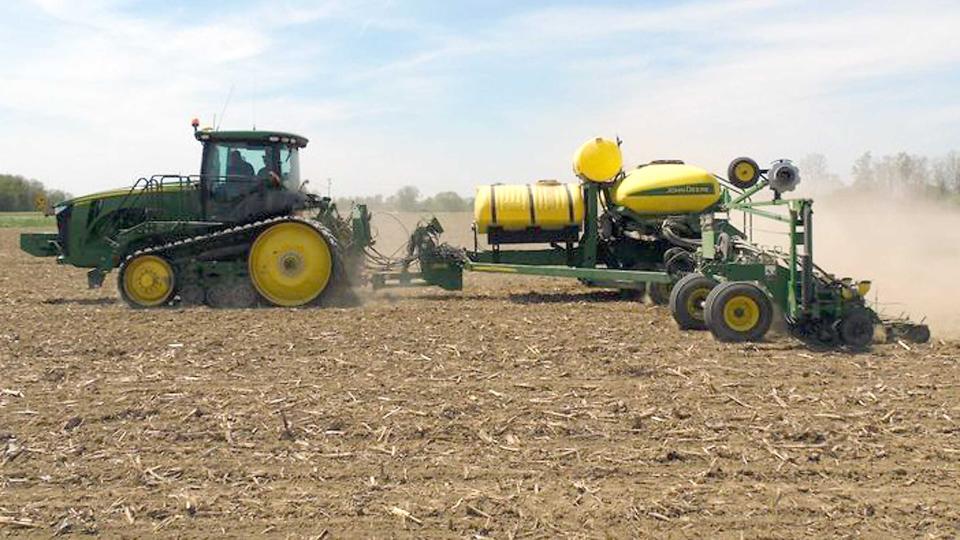Homegrown: Reducing sidewall compaction in field crops

The planting delays and a favorable 6-to-10-day weather outlook may cause some corn and soybean producers to begin planting into marginal soil conditions, increasing the potential for sidewall compaction to occur.
Sidewall compaction includes all soil compaction and soil smearing in and near the seed furrow and can restrict root growth and reduce crop yields.
Sidewall compaction typically occurs when planting into soil that is too wet, planting too shallow and setting too much down pressure on the gauge wheels and closing wheels. Sidewall compaction is never beneficial and is most-damaging when the soil becomes dry after planting.
Since sidewall compaction is detrimental and cannot be alleviated when it occurs, it should be prevented when possible. The most effective way to prevent compaction is to wait until soil moisture conditions are suitable for planting. This is easier said than done, given the calendar date and planting delays we are experiencing. It may be easier to wait for good conditions if you calculate planting capacity and review ways to increase it by improving efficiency.
For example, a producer planting at 5 mph with a 40-foot, single-fill planter or air-seeder and using bulk seed can cover about 19 acres per hour, assuming 80 percent planting efficiency. The planting efficiency drops to 65% when planting corn, so 16 acres per hour can be planted with a 40-foot planter operated at 5 mph.
There are several methods for determining if the soil is too wet to plant. Paul Jasa, agricultural engineer at the University of Nebraska, recommends the following to assess planting conditions:
Collect a handful of soil from your desired planting depth and squeeze the soil in your fist. If moisture and soil cling to your palm, the soil is too wet.
Take a similar soil sample and form it into a ball and drop it to the ground from about waist-high. If the ball remains mostly intact or breaks into only a few pieces, the soil is too wet.
You can also evaluate how equipment is operating in the field. If soil is building up on the rubber closing wheels, the soil is too wet to plant. You should inspect the seed furrow periodically for signs of soil smearing and sidewall compaction. To check for sidewall compaction, dig across the seed furrow and look for unbroken, v-shaped walls left by the opener.
Also, check to make sure the seed furrow is closed while using minimal down pressure on the closing wheels. Angled closing wheels are designed to perform best when planting at a depth of 2 inches. The risk of the seed furrow not being closed or opening up increases with shallower planting depth.
Jasa provides excellent recommendations for reducing sidewall compaction when planting into less than ideal soil moisture conditions. Among the recommendations:
Reduce the down pressure on the gauge wheels and the closing wheels. This is one of the most important adjustments you can make.
Leave some crop residue over the row to delay soil drying and reduce crusting.
Level the planter from front to rear or operate it slightly tail-down to improve seed-to-soil contact and seed furrow closing. The closing wheel arm must be level for angled closing wheels to function properly.
Use seed-firmers to improve seed-to-soil contact when using two spiked closing wheels per row to breakup sidewall compaction.
Various types of spiked closing wheels are available. Closing wheels that have long, straight tines are more aggressive than those with short or curved tines. The aggressive closing wheels tend to dry the soil and may require a seed-firmer to improve seed-to-soil contact and a drag chain to level the soil.
Consider adding one spiked closing wheel per row. This breaks up the sidewall compaction on one side of the furrow and closes the seed furrow more effectively in a wide range of conditions.
Stagger the closing wheels to reduce potential for the seed furrow to open up as the soil dries. If using one spiked wheel and one standard rubber wheel, place the spiked wheel in front.
Sidewall compaction will reduce your crop’s yield potential from the start of the growing season. Try to be patient and wait for suitable planting conditions, if possible. If this is not possible, follow the recommendations provided by Jasa to reduce sidewall compaction.
This report was made possible by a partnership involving Michigan State University Extension and the Michigan Soybean Committee.
This article originally appeared on Sturgis Journal: News
